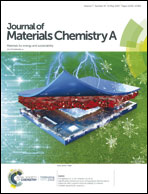Effect of proton irradiation on electrocatalytic properties of MnO2 for oxygen reduction reaction†
Abstract
Significant efforts have been made to enhance the poor intrinsic electrocatalytic activity of MnO2 toward the oxygen reduction reaction (ORR) for practical applications in fuel cells and metal–air batteries. However, the main bottleneck problems of the MnO2 catalyst for the ORR include the poor conductivity and the low activity compared to state-of-the-art Pt/C. Here, high power proton particles (14 MeV) were irradiated on MnO2, and numerous oxygen vacancies were introduced into the surface of MnO2 by decomposing water radiolytically along the proton beam. Compared with the pristine MnO2, the proton-treated MnO2 showed a much higher current density of −4.6 mA cm−2 at 0.65 V vs. reversible hydrogen electrode (RHE). The proton-treated MnO2 exhibited excellent catalytic durability, maintaining 95 % of its activity after a 10 000 s chronoamperometric stability test. This outstanding ORR performance and stability can be attributed to the improved physicochemical properties resulting from the proton beam irradiation. This study provides a novel approach for the generation of oxygen vacancies by proton irradiation, improving the catalyst for use as an advanced electrode material.


 Please wait while we load your content...
Please wait while we load your content...